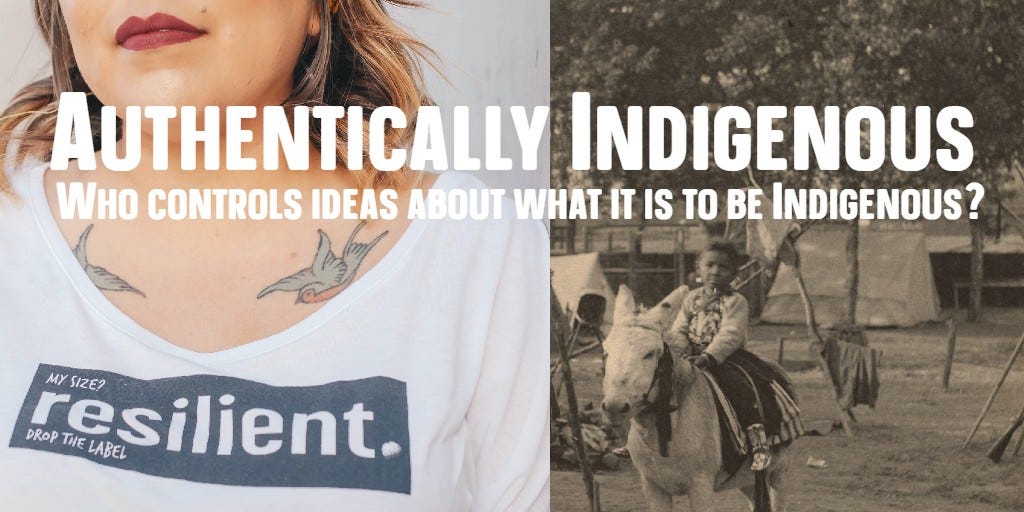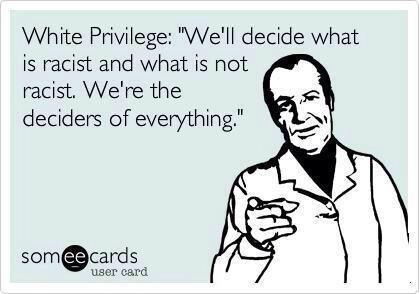Text within this block will maintain its original spacing when publishedIn the Great American Indian novel, when it is finally written, all of the white people will be Indians and all of the Indians will be ghosts.
—Sherman Alexie, How to Write the Great American Indian Novel
Text within this block will maintain its original spacing when publishedthis week, she said I’m really upset you’re telling the same story three times because there’s only one story about Indians and we all know what it is so I asked her if there are an infinite number of stories about white people and she told me to stop being racist
~ Cheryl Savageau, graduate school first semester: so here I am writing about Indians again

Authenticity.
Who controls ideas about what it means to be Indigenous, and for what purpose? Because when people who aren’t us take it upon themselves to decide who is us, it inevitably leads to disregarding and dismissing. Unless we meet their criteria, rooted mostly in TV and advertising copy, we aren’t authentic enough to be taken seriously. In the decade and a half that I spent doing child welfare I often heard workers complain that parents used being Indigenous as leverage when it suited them but didn’t otherwise act Indigenous. This shows up everywhere, in academia and social services, in schools and hospitals, in communities and churches. In our own communities and in yours.
What does that even mean.
This is not an essay about those who would pretend to be Indigenous in order to gain access or credibility. They don’t seem to have any trouble projecting authenticity. And this isn’t really an essay about Hollywood representation either, although it matters. It’s about how we are seen, or not seen, as Authentic Indigenous People and the belief that wanting to be seen as Authentic is somehow connected to a desire for privilege or access to something we may have no right to. To return to my experience in child welfare, dismissing the Authenticity of parents serves two purposes. Indigenous children are over-represented in child welfare just as their parents are over-represented in prisons, so questioning the Authenticity of their parents could reduce those numbers, or reduce their meaning. Sure the stats say 25% of kids in care are Indigenous, but they aren’t REALLY Indigenous. They aren’t Authentic. Questioning the Authenticity of the parents also absolves the foster parents of making accomodations in their homes to care for their children. If the parents aren’t Authentically Indigenous then there’s nothing to accomodate, no changes need to be made.
Making decisions about Authenticity has consequences.
While I laugh at natives who suddenly sound all rez when they talk to white people I also get it. My big beaded earrings accomplish the same thing. Look! I’m authentic! I grow my hair long and don’t use sunscreen and wear the biggest bling earrings so that I can at least look authentic and that’s really sad isn’t it. But I grew up in the 70s and 80s and didn’t know any Indigenous people, so TV and advertising copy was also where I learned what Authentic Indigenous people were like. Just like most of you. Hashtag probably. Hashtag sad. Hashtag we’re still here but where are we.
I used to wish I was Cherokee or Apache or somebody cool. Even though I lived in Southern Ontario nobody knew who the Ojibwe were. Except in history books when we helped the French, or maybe the English I forget. But we helped them for a while and then we disappeared into the woods I guess. At least the Plains Indians stayed around in movies, all those feathers and horses and staring majestically into the sunset. One single tear like Iron Eyes Cody.
Maybe they were just more visible in the grasslands where there’s nothing to hide behind. My father’s people are north of Kenora where it’s all small lakes and swamp filled with blackflies. Even the Lakota, tough as they are, decided we could keep it. Good place to stay hidden from white colonizing eyes. We didn’t wear buckskin with romantic fringes like the Plains Indians do in the movies. They drag in the water and get stuck on branches so even our clothes didn’t look much like the things you’d expect Authentic Indigenous People to wear. But hypervisibility doesn’t seem to be any better than invisibility. You aren’t actually seen either way, and the way that you are seen when you are hypervisible just lands you in residential schools or foster homes or jail. In the healthcare system being hypervisible means getting your pain dismissed, your symptoms assumed to be intoxication, and your medical care entirely inadequate.
Rebecca Roanhorse starts her 2017 short story Welcome to Your Authentic Indian Experience TM (which I encourage you to take a moment to read because there’s a spoiler later on) with this quote from Alexie. I liked how evocative and plaintive this poem is. The entire thing is filled with stereotypes that would be poignant if they weren’t so painful. He writes about visions and alcohol, half-breed Indians who are obviously from horse cultures. Warrior men who, if they weep at all, weep alone and mysterious women who paint with the colours of the wind when they aren’t healing somebody. The novel will of course include white people who are Indian deep inside or in another life or whose GGG grandparent becomes their entire personality. A few years ago I asked Twitter for a different poem because Alexie has been credibly accused of some predatory sexual behavior, which he denies, and somebody suggested the poem by Cheryl Savageau in which she writes about seeing Indians in the history books she was reading or artwork they were looking at. Not that they were visible in any way because they weren’t, but she knew they were there so she wrote about the absence and it upset her teacher. Stop writing about what isn’t in the text, her teacher says. Which, Cheryl responds, is just our entire history.
There is only one story about Indians, and we all know what it is. That’s the Great American Indian Novel that Alexie is describing. The single story that we all have and to which I compared myself as a woodlands child being raised by her white maternal family. That comparison against which I was always found wanting. Not authentic. And if you aren’t authentic you can’t make demands, because if you do and you aren’t authentic then the other party is under no obligation to respect them. As if they would anyway. That’s the great thing about being the deciders of everything.

In her Great American Indian Short Story Roanhorse explores Authenticity through a man who works for a company in Sedona that has created a VR vision quest for white tourists. Jesse gives tourists the kind of Authentic Indian leading an Authentic Experience that they are looking for, rather than the authentic life he is actually living. His real name is Turnblatt, not Trueblood which he uses at work because he thinks it sounds more Indian. His wife tells him that his real name is Indian-sounding because he’s an Indian, and Jesse laments that they aren’t the right kind of Indian. The story has a twist though, given away in her choice of epigraph, because one of his tourists winds up taking his place at work and at home, and it turns out that it was actually Jesse who is the tourist getting an Authentic Indian Experience TM. Rather than that single story about Indians that Alexie wrote about and which Savageau pushed against, Jesse did get an authentic experience of what it is to be Indigenous in this world.
What does it mean to be native, to be authentic. Whose ideas about authenticity are we trying to live up to and what is the cost of that.
I don’t know. But I know that when the Deciders of Everything take it upon themselves to decide who is authentic, that has some consquences for us.
Catch me on the Faith in a Fresh Vibe podcast! Two episodes you can listen to right here. I wrestle through some of these ideas about authenticity and growing up wanting to be authentic, but not knowing how. Second episode gets into whether or not the church can decolonize.
On Becoming Kin and Finding Your Identity
We Make The Road by Walking On It.
Authentically Indigenous
Who controls ideas about what it is to be Indigenous?
